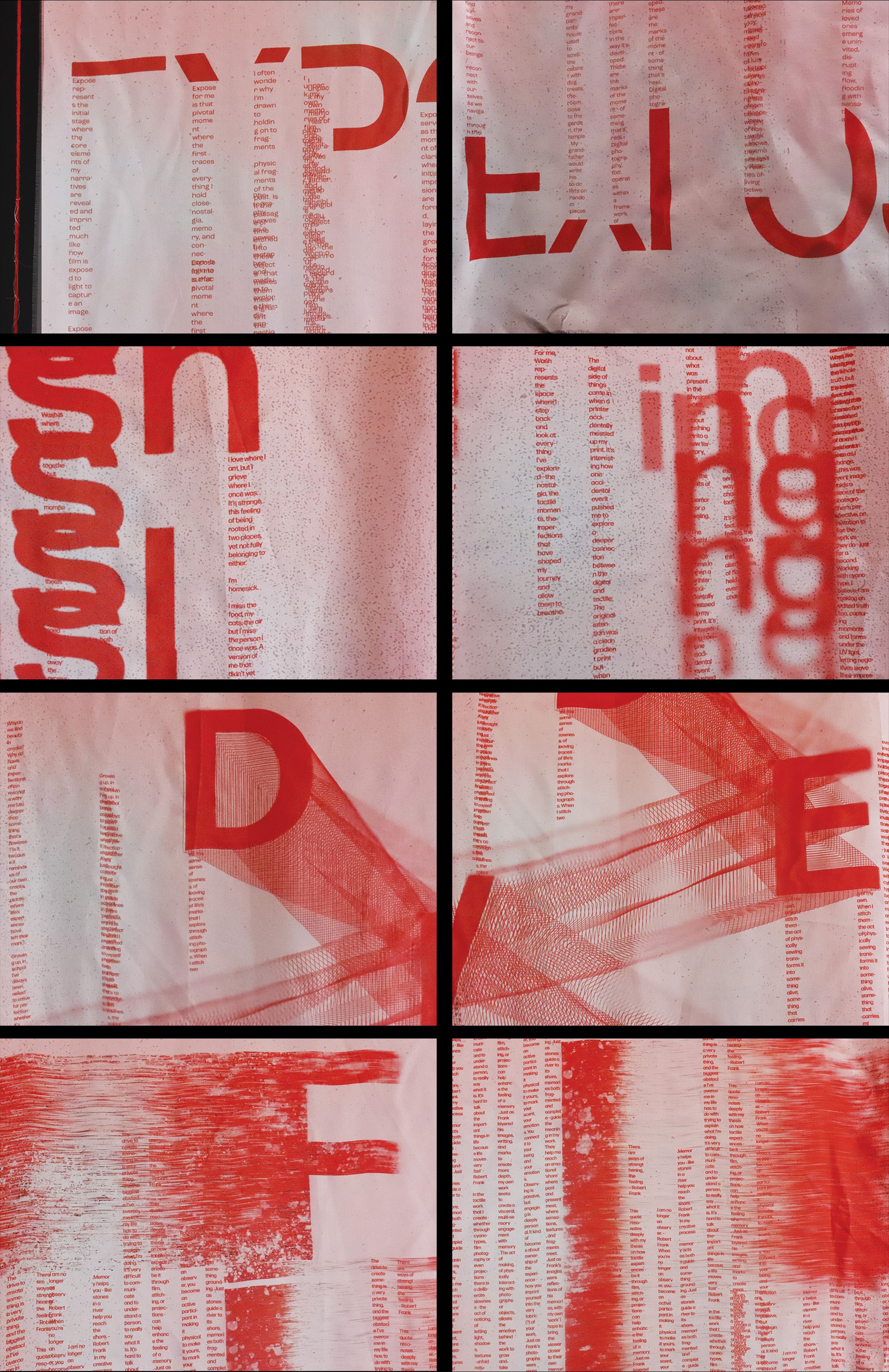7/24/2024 by Anmol Baliga
Expose // Revealing the unseen, exposing layers
Part 01
We are slowly losing touch - both literally and metaphorically - with tactile experiences. In this increasingly digitised world, the tactile experiences that once shaped how we connected to each other has been greatly lost. My thesis, Develop(ing) Narratives, seeks to address this disconnect by exploring the importance of tactile engagement in storytelling. I’m looking into merging the tangible and digital and tactile coexisting with the digital to create deeper, more meaningful connections, narratives.
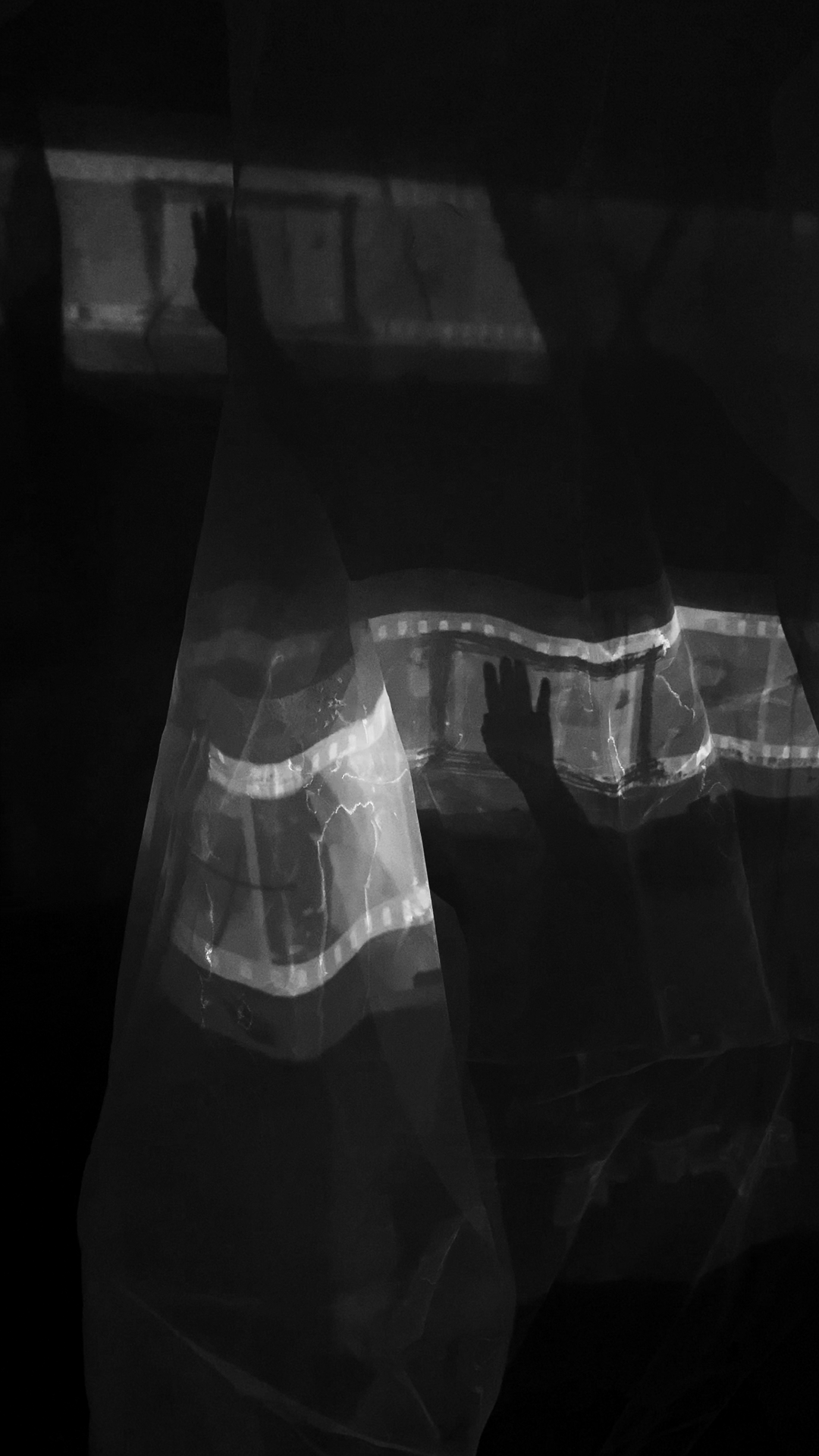
‘There is a crack in everything; that’s how the light gets in’ - Leonard Cohen
Why do we find beauty in cracks? Why do flaws and imperfections often resonate with me (us) deeper than something that’s flawless? Is it because it reminds us of our own cracks, the places where life’s experiences have left their mark?
A conversation with Liz Steketee
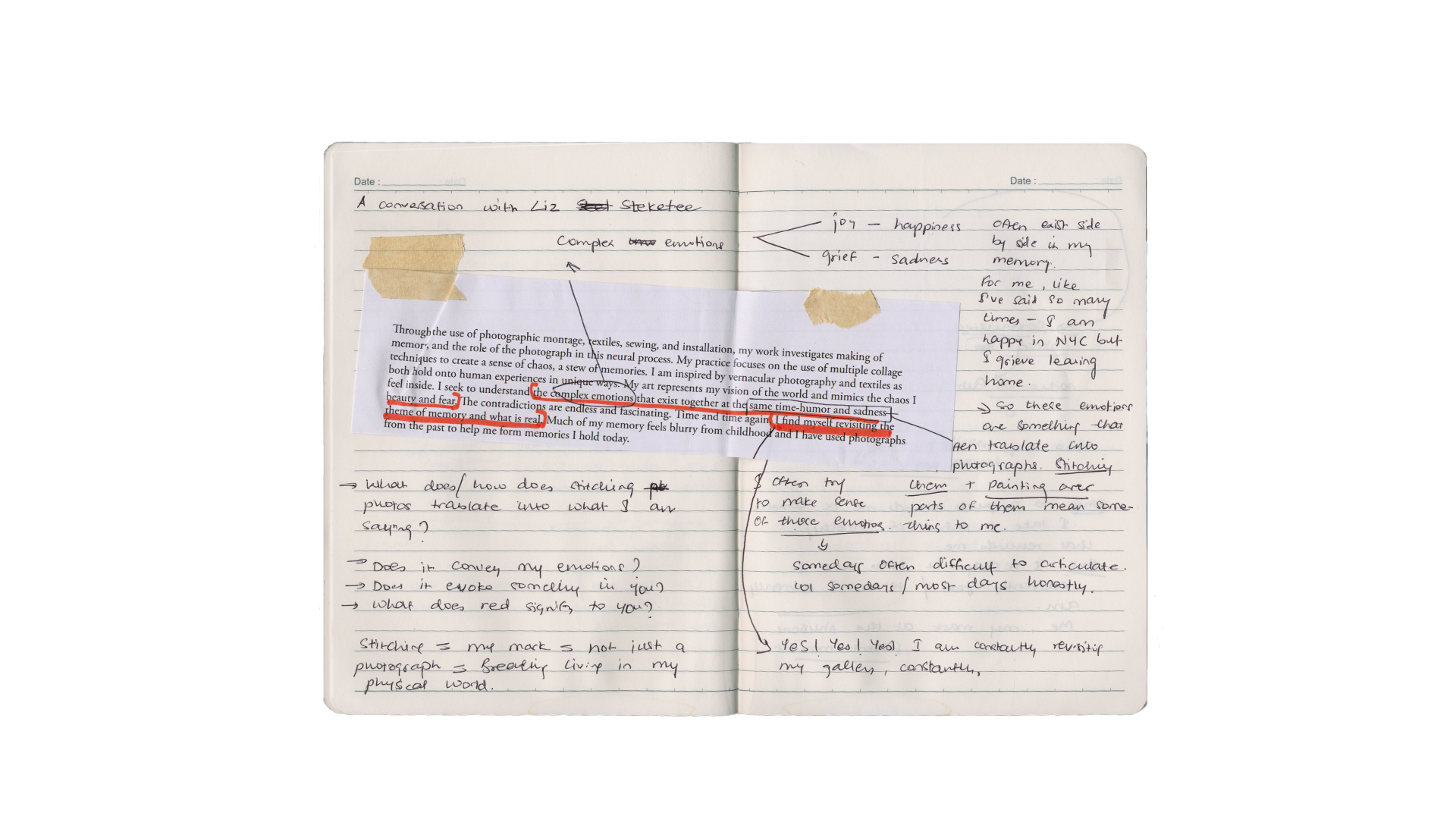
'My art represents my vision of the world and mimics the chaos I feel inside. I seek to understand the complex emotions that exist together at the same time - humour and sadness - beauty and fear. The contradictions are endless and fascinating. Time and time again, I find myself revisiting the theme of memory and what is real. Much of my memory feels blurry from childhood and I have used photographs from the past to help me form memories I hold today.'
The conflicting emotions - joy and sorrow often exist side by side in my memory. It's grieving and loving at the same time. When I stitch and paint over these photographs, making a mark - I feel like I’m trying to make sense of those very blurred emotions - trying to give form to those emotions - that don’t really ‘fit’ in any category. When I work on these photographs - it's as if I’m translating my emotions into the material - they no longer are static - they become living, breathing - tactile.
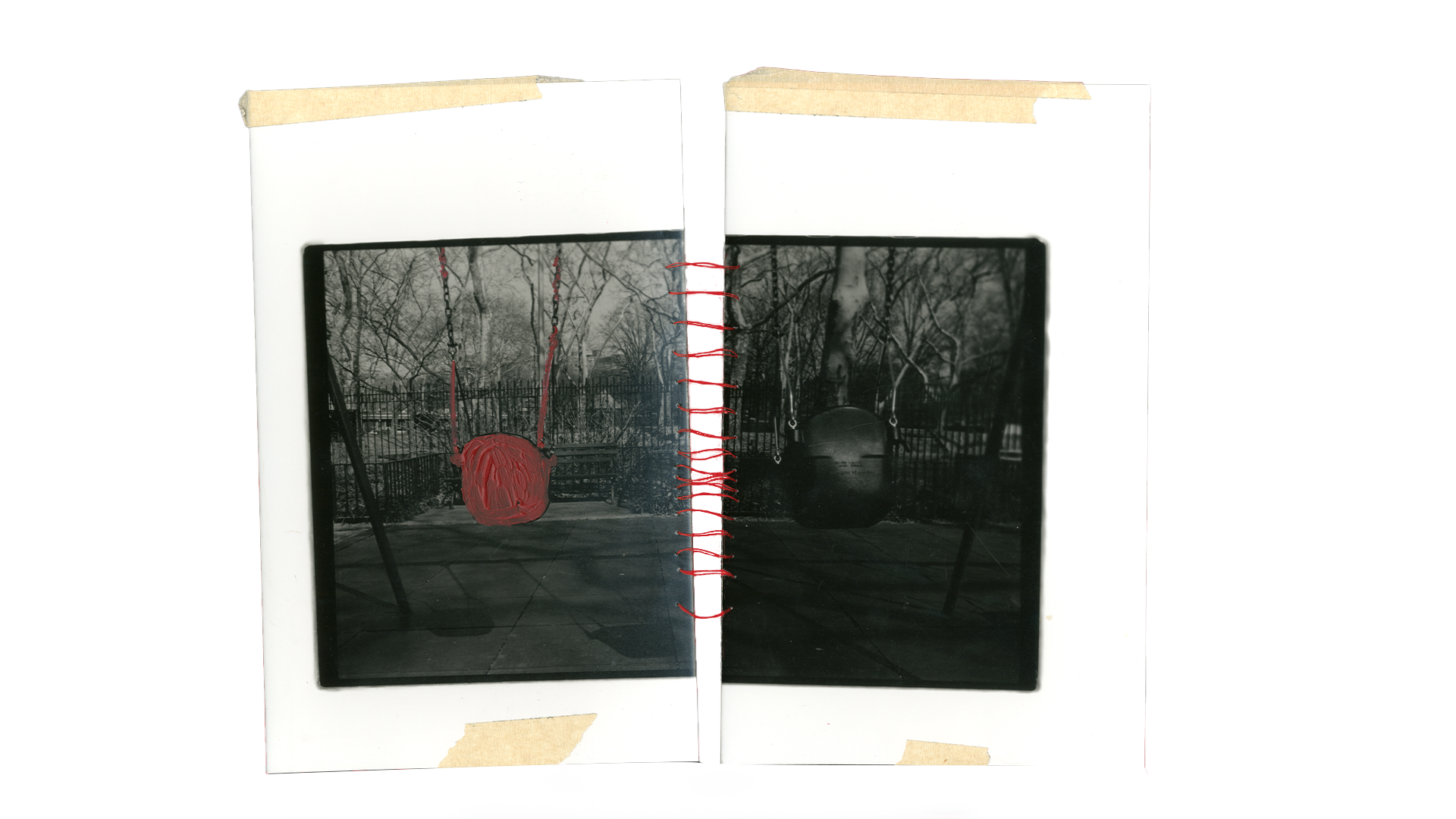
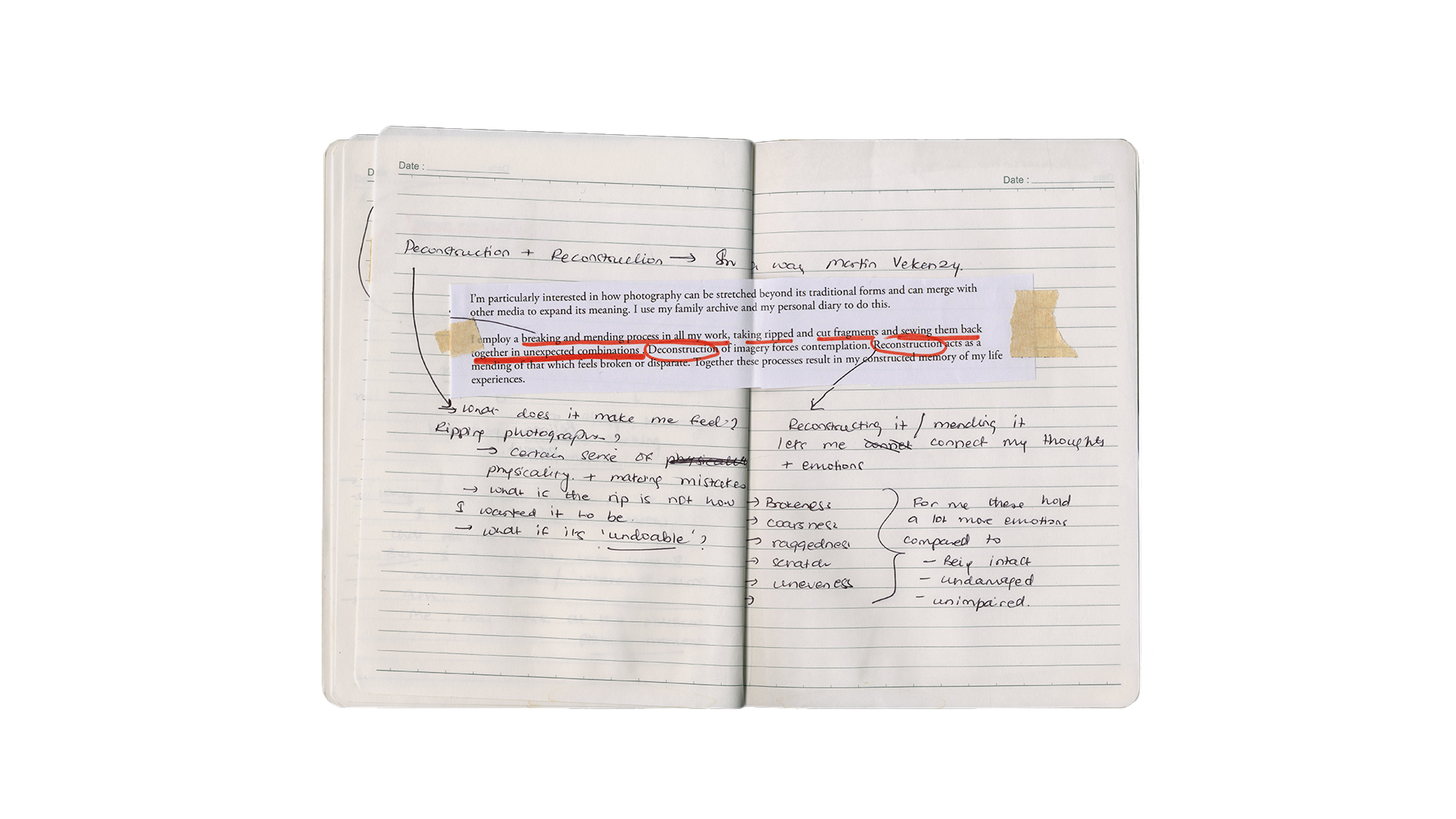
'Breaking and mending… Deconstruction of imagery forces contemplation. Reconstruction acts as a mending of that which feels broken or disparate.'
I find this deconstruction and reconstruction process to be meaningful in my work. When I cut, tear and stitch photographs, there is a certain physicality to it that forces me to engage with the emotional (residue) of the past. Each rip gives me a sense of emotion. I find the brokenness of some of my images mirror how I some days experience memories - fragmented and flawed.
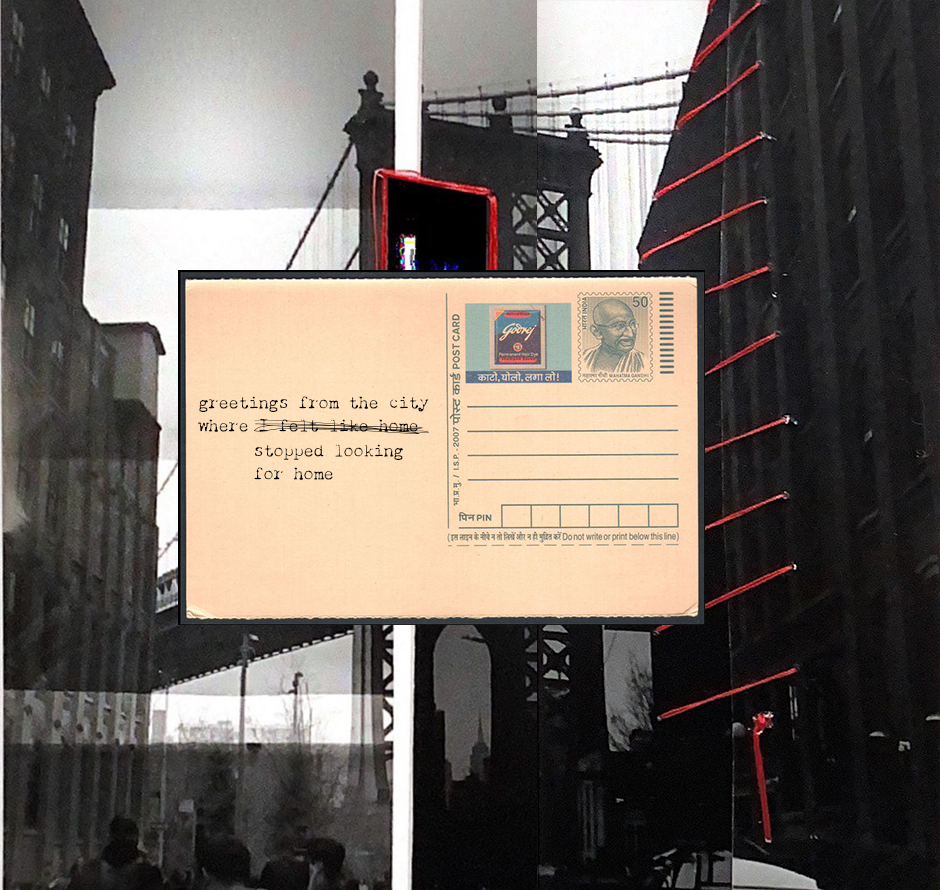
7/26/2024 by Anmol Baliga
Expose // Revealing the unseen, exposing layers
Part 02
Pixels to Palpable
In digital methods - control is constant. The pixel perfect image, the lines, the layers that can be adjusted and manipulated with precision. It feels worlds apart. Yet, digital glitches - those unexpected distortions, errors remind me of the value in chasing something beyond perfection. A pixel misalignment, an accidental colour shift - these glitches too possess a kind of imperfect beauty. These glitches in the digital world become a moment of discovery. They become opportunities to explore the accidental, the unintentional, in a space where precision is the go-to ‘default setting’. Instead of correcting these errors, I find myself leaning into the, curious about the ways they push my work into the unexpected directions.
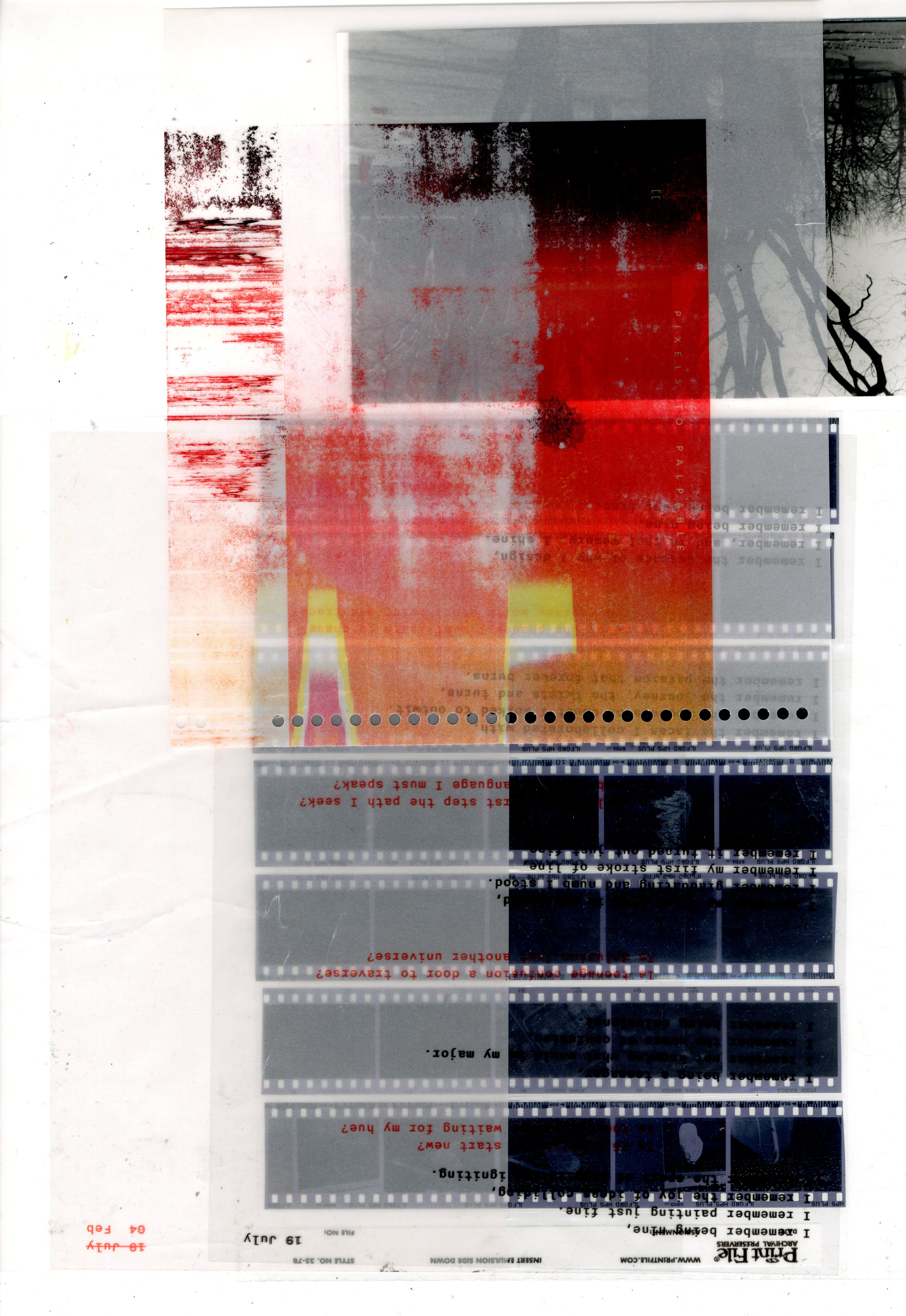
In my exploration of both analogue and digital mediums, I’ve found ways to merge the tactile nature of traditional materials with digital. In these pieces of work - the lines between physical and the digital are never as clear cut as they seem. There's something deeply satisfying about scanning physical objects, whether it's a misprinted piece of paper, piece of film or just my hands and bringing them into the digital world. By manipulating these scans, I can carry these physical elements of the physical world into the digital, layering in textures, marks and distortions that were once only a part of the physical. At this point for me it’s not about what was present in the physical world but it's about pushing it into a new territory, like stretching the limits of a memory or a feeling.
The digital side of things came in when a printer accidentally messed up my print. It's interesting how one accidental event - pushed me to explore a deeper connection between the digital and tactile. The original intention was a clean gradient print but when the paper got stuck, the machine left its mark in the form of unexpected creases, streaks and smudges. Initially, I considered discarding the print - but as a certified hoarder - I held on to it. The chaotic print evoked a feeling. The texture felt alive - because I could actually feel the creases, the smudges - a tangible scar left by the machine felt like a part of the print itself.
So, rather than correcting the glitch, I scanned the ‘damaged’ print to capture its physical texture. Then I overrated the scans on a poem, deeply personal and a few negatives that I had in hand. This layering process, merging the physical marks of the work with the rawness of digital accidents - made me rethink the nature of my work. Like mentioned before - the digital glitches and something beautiful comes out of it when it does. It creates a dialogue between the tactile work I had engaged with physically and the digital image - now reimagined through a different lens.
A conversation with Martin Venezky
The idea of uncertainty in Martin Venezky’s work speaks to that visceral, intuitive process that I value. It’s a reminder that sometimes meaning comes through only as you interact with the work, rather than being something fixed right from the start. I find that slowing down and observing allows the work to speak for itself, rather than pushing it into a preconceived form.
These digitally manipulated distortions create a conversation between the original physicality and the fluidity of digital tools - reminding me that even within the confines of ‘precision’, there is room to go beyond the traditional boundaries. The digital space is not just a place for control but an area for transformation - where these glitches can open up entirely new spaces for creativity. And like Venezky said in an interview - cutting, scanning, taping could be a ‘dumb way of working’ but there’s something liberating about letting go of the grid or the baseline and embracing the messiness and awkwardness. I find that tension between the structure of digital tools and the rawness of human touch, whether through a brush stroke, scans or a glitch - allows me to create something that feels alive - the spirit of the physical into the digital without letting go of visceral, hands-on connection.
Working slowly, allowing the process to be both organic and intentional - mirrors that slow evolution of meaning and interaction. It’s in those moments of uncertainty and spontaneity - when things aren’t perfectly aligned - that I feel the most connected to the work and to the memory, the feeling or the message I’m trying to convey.
1/16/2025 by Anmol Baliga
Wash // Washed by sensation, flooded with memories
Making Documentation // Develop(ing)
Expose
The first layer expose // represents the initial act of revelation - the moment when a memory is exposed - it comes to light often uninvited. Like how film is at its most vulnerable state when exposed to light without it being completely developed - this layer is about vulnerability - all about letting the memories come forward.
In designing this poster, I wanted to capture the feeling of being exposed - so the typography is almost split into two - uneven - broken and fractured to convey the fragility of this stage. The text inside it shows how I feel about being exposed - about the act of exposing oneself to memories, even the painful ones. The first layer is an invitation to viewers to almost peel and confront these flashes of memories in order to go to the second layer.
Wash
With wash I entered a stage where memory becomes fluid, malleable as though washed over by waves of sensation. In designing this poster, the typography layout was almost like water dripping, like a flowing pattern - washing like reliving - a process that submerges these memories in water (read as sensation) softening the edges, the colours but in fact deeping the emotions within.
This stage felt like stepping into memory, letting it wash over me rather than attempting to control it. With this layer, I invite viewers to immerse themselves in memory, encouraging them to relive their own fragmented memories.
Develop
Finally, Develop, where memory becomes a composite. Here, each fragment, each layer builds towards a whole, a more complex experience. Development is not just what is visible but its about what has been exposed, washed and fixed and finally reached towards the end - develop.
In this poster, I tried to show the process of development typographically. Some words, like the O and E are in the process of getting developed and the last few words (ing) are close to being pixelated to show the environment we’re living in. It's digital yet tactile. This interplay of physical and digital elements and how even in this virtualized environment - our experiences remain tangible and deeply felt - if we let them.
Weaved Narrative
At the end of this process, I created a woven narrative, a woven poster - taking fragments of my thesis abstract and weaving them into a physical piece. This weaving is both symbolic and literal - it brings together the scattered elements of my narrative, binding memories and moments into a single (not really single) form.
With this particular piece I wanted to reflect how memory is not just a linear record but in fact a woven piece from different thoughts, texture, time, each strand carrying its own weight and memory.
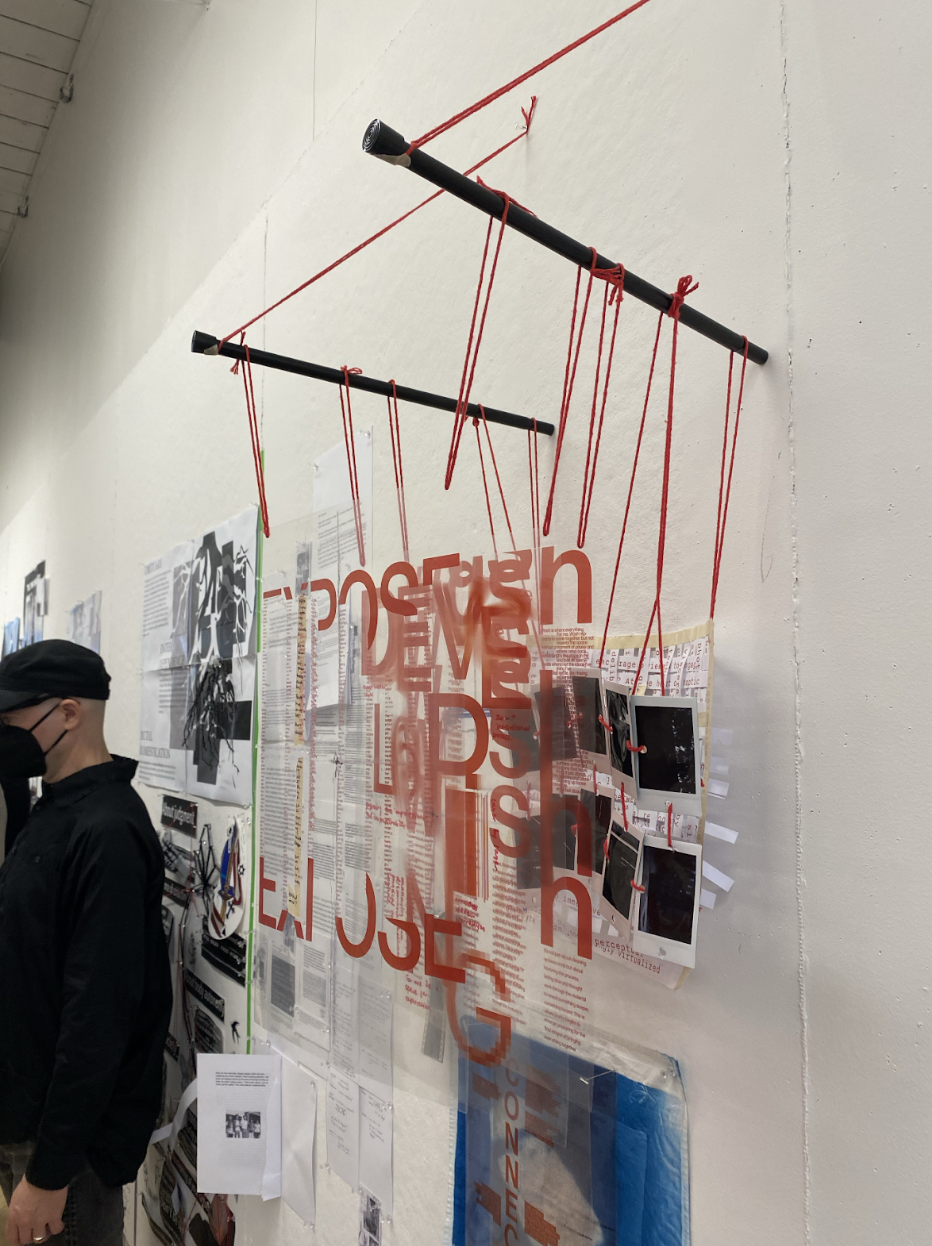
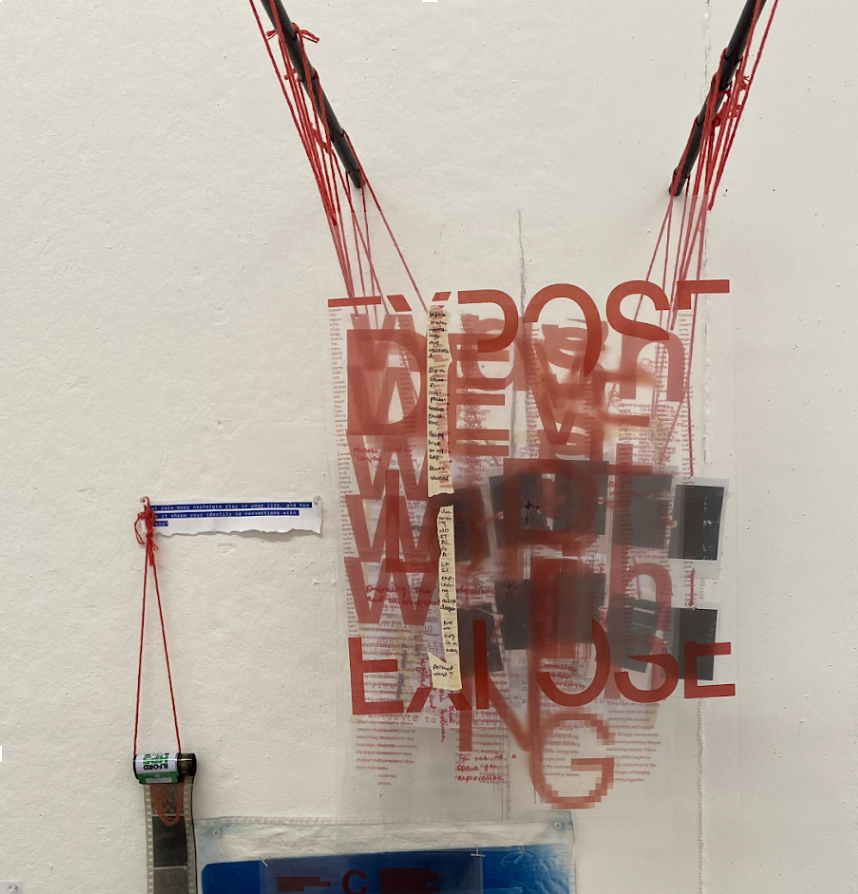
4/10/2025 by Anmol Baliga
Dry // Sealed in time, space for reflection
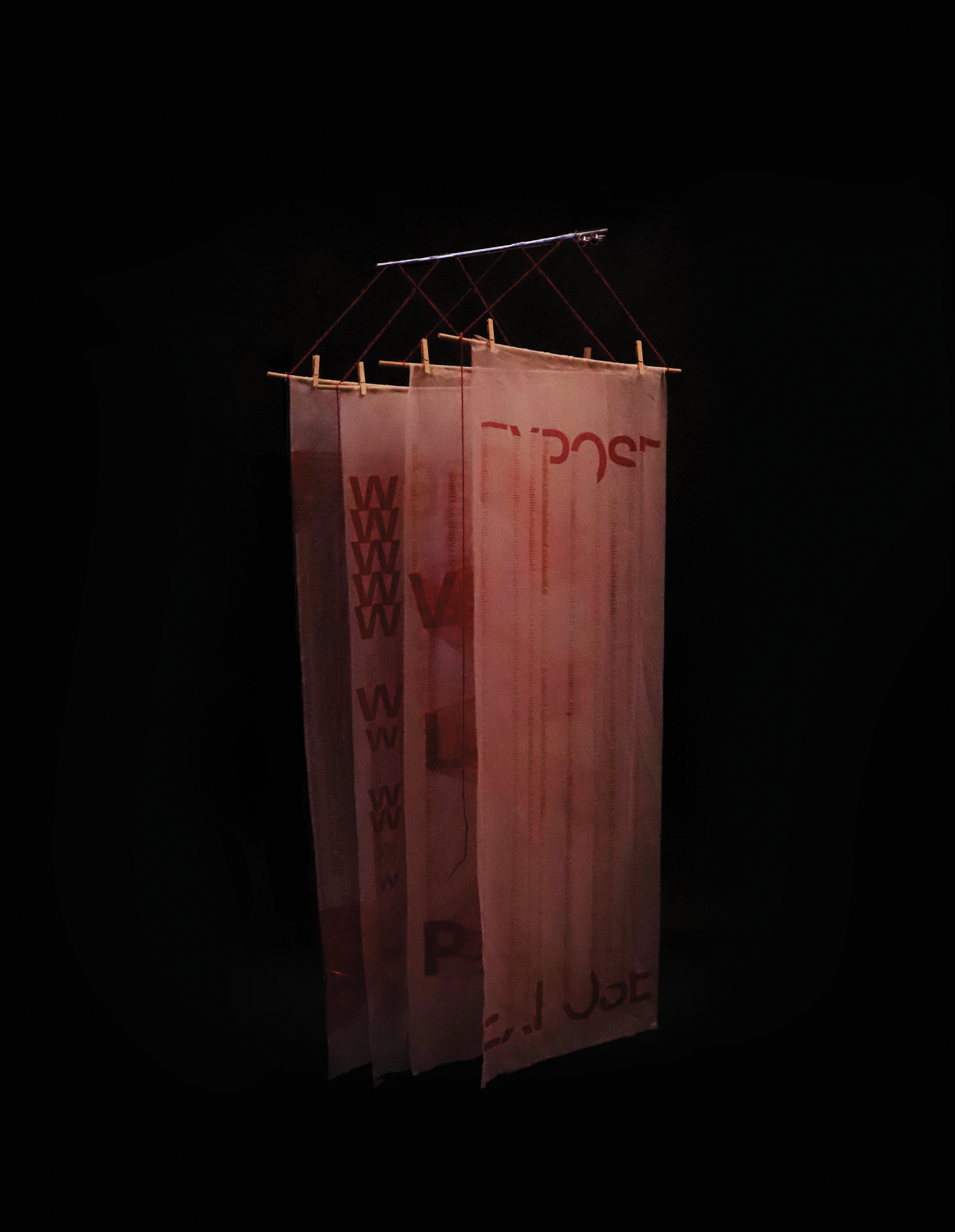
For the final stage of my thesis, I aimed to create a space that would invite reflection on a deeply personal level, immersing viewers in a narrative constructed from layers of time, memory, and tactile experience. The installation, comprised of large-scale panels - a version of my layered posters - printed on chiffon cloth - designed to be more than a visual composition - it was meant to be an environment that enveloped the viewer. Ultimately creating an experience that is both intimate and expansive, one that invites them to step into a living, breathing conversation between the past and present.
The panels, each 2 x 5 feet in size, were printed on sheer, translucent chiffon, a fabric that would allow light to pass through and gently obscure the details within - mirroring how memories often blur and fade over time. I digitally added texture to these prints, a subtle reminder that, even in the digital world, tactile elements can alter our perception of the image. The textures were layered making sure it wouldn’t dominate, but to suggest the marks left by time - the scratches, the imperfections, the traces of life. The aim was to allow viewers to feel the weight of time through the texture of the cloth, each fold, wrinkle, and imperfection adding another layer to the narrative.
Hanging these pieces from wooden rods, with the same clothes pins that are used in darkrooms to hang developed prints, I wanted to evoke a sense of nostalgia and familiarity - the process of developing photos in the darkroom. The act of hanging these prints, as if still in the midst of development, was a deliberate choice. It connected the space to the time-consuming, hands-on practices that I hold close, while subtly inviting the audience into that process. They were not static objects to be observed from a distance, but pieces that seemed to exist in a state of flux, much like memory itself.
